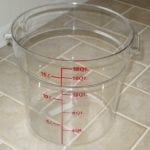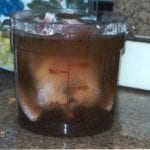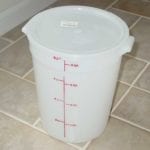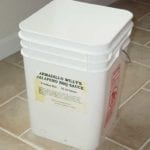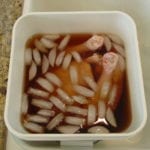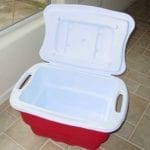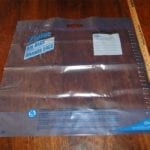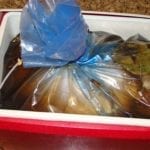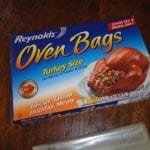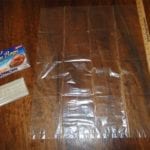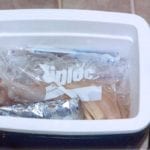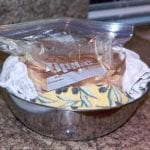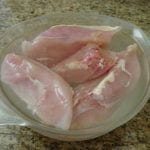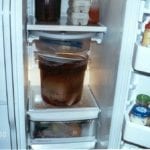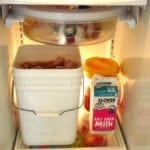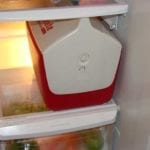In This Topic
- What Is Brining?
- How Brining Works
- Meats That Benefit From Brining
- Which Salt To Use
- Kosher Salt Measures Differently Than Table Salt
- How Long To Brine
- Choosing A Container
- Estimating The Amount Of Brine To Make
- No Need To Adjust Solution When Brining More Meat
- Refrigeration Is Required
- To Rinse Or Not To Rinse After Brining
- Air-Drying Brined Poultry Skin
- Brining Enhanced Meat & Self-Basted Turkeys
- Brining Water-Chilled Vs. Air-Chilled Chicken
- Low-Salt Brining Doesn’t Work
- Using Salt Substitutes In A Brine
- Brine Should Not Be Reused
- Freezing Brined Meat
- How Much Sodium Is In Brined Meats?
- Recipes To Get You Started
- More Brine Recipes & Related Articles
This article explains how brining works, which cuts of meat benefit most from brining, and provides several recipes to get you started.
What Is Brining?
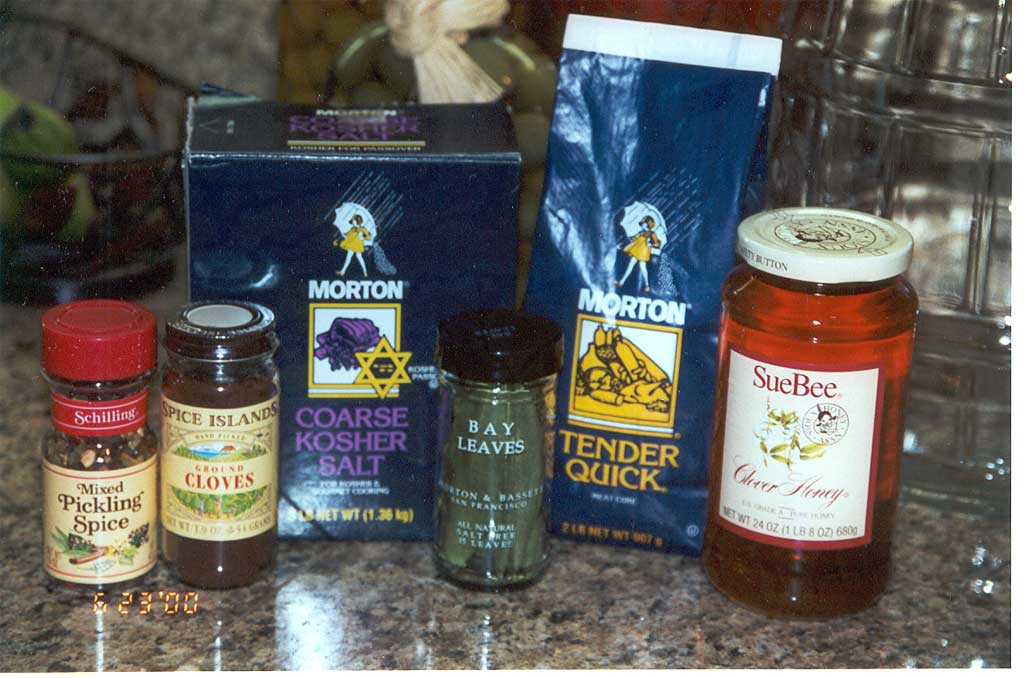 Brining is a method for improving the flavor and moisture content of lean cuts of meat like chicken, turkey, pork and seafood. This is achieved by soaking the meat in a moderately salty solution for a few hours to a few days. Brining also provides a temperature cushion during cooking—if you happen to overcook the meat a little, it will still be moist.
Brining is a method for improving the flavor and moisture content of lean cuts of meat like chicken, turkey, pork and seafood. This is achieved by soaking the meat in a moderately salty solution for a few hours to a few days. Brining also provides a temperature cushion during cooking—if you happen to overcook the meat a little, it will still be moist.
At a minimum, a brine consists of water and salt. Other ingredients may be added for additional flavor, including sugar, brown sugar, honey, molasses, maple syrup, fruit juices, beer, liquor, bay leaves, pickling spices, cloves, garlic, onion, chilies, citrus fruits, peppercorns, and other spices. Some recipes call for bringing the ingredients to a boil to dissolve the salt and sugar and bring out the flavor of the spices, then cooling the mixture to below 40°F before use.
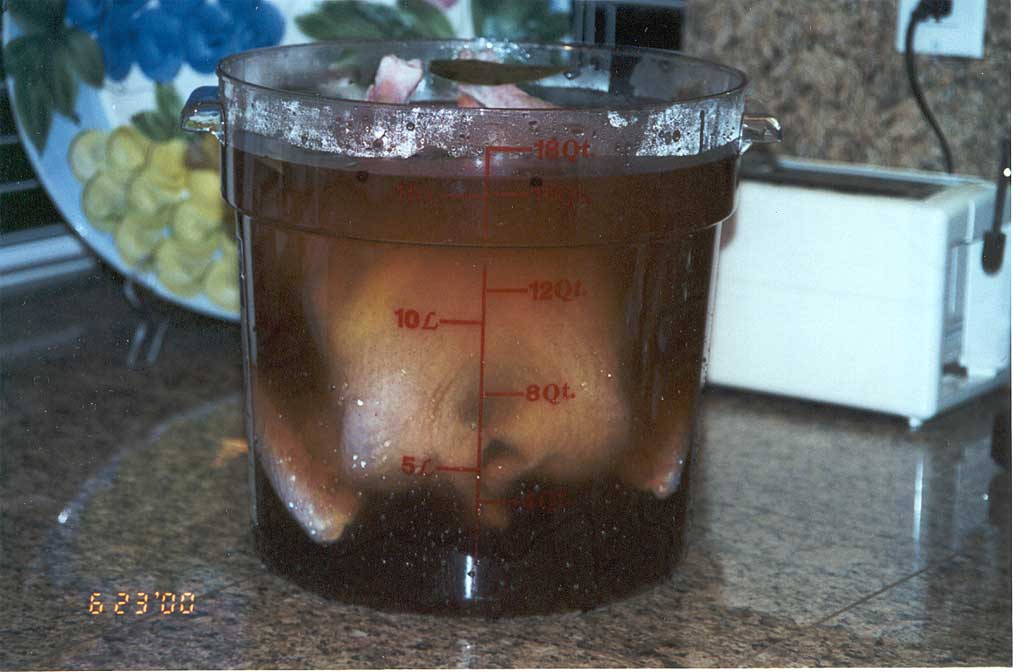 Sometimes a small amount of a curing agent like sodium nitrite or Morton Tender Quick (a mixture of salt, sugar, sodium nitrate, sodium nitrite and other ingredients) is added to a brine. These curing agents create a color and taste reminiscent of ham and help prevent the growth of botulism. This is important when cold smoking brined meat at temperatures below 140°F or when smoking a large brined turkey that might not reach 140°F internal temperature within the first 4 hours of cooking. Sodium nitrite and Morton Tender Quick can be purchased at butcher supply stores or from suppliers like Allied Kenco or Amazon.com. Tender Quick is also sometimes found in larger supermarkets.
Sometimes a small amount of a curing agent like sodium nitrite or Morton Tender Quick (a mixture of salt, sugar, sodium nitrate, sodium nitrite and other ingredients) is added to a brine. These curing agents create a color and taste reminiscent of ham and help prevent the growth of botulism. This is important when cold smoking brined meat at temperatures below 140°F or when smoking a large brined turkey that might not reach 140°F internal temperature within the first 4 hours of cooking. Sodium nitrite and Morton Tender Quick can be purchased at butcher supply stores or from suppliers like Allied Kenco or Amazon.com. Tender Quick is also sometimes found in larger supermarkets.
It’s important to point out that not everyone likes the effects of brining on meat. Some people don’t like the texture of brined meat, saying that it seems spongy. Others complain about flavor, saying that it makes meat taste too salty (or hammy if sodium nitrite or Morton Tender Quick has been added to the solution). In the end, you’ll have to try brining and judge the results for yourself.
How Brining Works
There is general agreement among food scientists that osmosis is the primary force behind brining. The Merriam-Webster Online Dictionary defines osmosis as “movement of a solvent through a semipermeable membrane (as of a living cell) into a solution of higher solute concentration that tends to equalize the concentrations of solute on the two sides of the membrane.”
Osmosis attempts to balance the distribution of water and salt between meat and brine. Meat is mostly water, about 60-70%, and contains very little salt. When meat is initially brined, salt is drawn from the brine solution into the meat, while some moisture is drawn from the meat into the brine. The meat contains more salt and less water than before it went into the brine.
With a bit more time, the salt begins to work its magic on the meat. Sodium and chloride ions interact with meat proteins, causing tightly wound bundles of protein to unwind and push apart. The muscle fibers relax and weaken, allowing more water and salt and flavorings to penetrate the meat. The meat now contains more salt and more water than before it went into the brine.
The relaxed proteins form a matrix that traps water molecules and holds on to them tightly during cooking, so that the cooked meat retains more moisture even if somewhat overcooked. When eating the cooked meat, it seems more tender because 1) the muscle fibers have been weakened in the brining process, and 2) our perception of tenderness is greatly affected by moisture content; moist meat is softer and perceived as being more tender than dry meat.
Cook’s Illustrated magazine brined several 11-pound turkeys for 12 hours and found an average weight gain of 12 ounces after brining and 6-8 ounces after roasting as compared with 11-pound turkeys that had not been brined. In the January/February 2004 issue, Cook’s Science Editor John Olson discussed an experiment in which three chickens were roasted and their weights compared. One chicken was cooked right out of the package, while the other two were soaked for the same length of time, one in plain water and the other in a brine solution. After roasting, the unsoaked chicken retained 82% of its original weight. Both soaked chickens gained 6% by weight during soaking, but the water chicken retained 88% of its original weight after roasting while the brined chicken retained 93% of its original weight. These results show that the salt in the brine solution plays an important role in moisture retention in meat.
The amount of time needed to brine meat depends on the cut of meat and its thickness. Thin cuts like pork chops and chicken pieces may need only 30-60 minutes of brine time, while a whole turkey can brine for 6-12 hours, with some recipes going as long as 24-48 hours. See How Long To Brine for details.
Meats That Benefit From Brining
Lean cuts of meat with mild flavor tend to benefit most from brining. The usual suspects include:
- Chicken: whole, butterflied, or pieces
- Cornish Hens: whole or butterflied
- Turkey: whole, butterflied, or pieces
- Pork: chops, loin, tenderloin, fresh ham
- Seafood: salmon, trout, shrimp
Poultry is probably the most commonly brined meat because it is naturally lean and gets quite dry if overcooked. Lean cuts of pork are also good candidates for the same reasons as poultry, except that in the case of pork, much of the fat (and thus flavor) has been intentionally bred out of the animal by an industry intent on providing “the other white meat” to health-conscious consumers.
Beef, lamb, duck, and other meats with high fat content and bold flavors do not benefit from brining—they’re naturally moist and flavorful. They also tend to be cooked to lower internal temperatures and thus don’t lose as much of their natural moisture.
Pork butt is not commonly brined because of its naturally high fat content, yet there are some recipes that do so. Brisket can be brined to become corned beef or pastrami depending on the seasonings used in the brine.
Which Salt To Use
Table salt is preferred for brining. Table salt is inexpensive and dissolves easily in water with some stirring. Canning and pickling salt is essentially the same thing as table salt but contains no iodine or anti-caking agent.
There’s no reason to use more expensive salts like kosher salt or sea salt. Some people say that kosher salt tastes “cleaner” than table salt because it does not contain the anti-caking agents added to table salt. Some people prefer non-iodized table salt over iodized table salt, believing that potassium iodide creates an off-taste. But any flavor differences melt away when salt is diluted in large quantities of water in a brine. In an article about salt in the September/October 2002 issue of Cook’s Illustrated magazine, taste testers felt that nine different salts “all tasted pretty much the same” when dissolved in water, whether it was 36¢/pound iodized table salt, 66¢/pound kosher salt, or $36/pound Fleur de Sel de Camargue sea salt from France.
Having said all that, it’s perfectly fine to use kosher salt or sea salt in a brine if that’s your preference.
See All About Salt to learn more about this important ingredient.
Kosher Salt Measures Differently Than Table Salt
Kosher salt consists of big, flaky crystals while table salt consists of small, sand-like crystals. As a result, they don’t measure the same by volume. A cup of table salt will contain a lot more salt crystals and will be much more salty in a brine solution than a cup of kosher salt. However, all salts have the same saltiness when measured by weight.
Table salt weighs about 10 ounces per cup, while kosher salt weighs 5-8 ounces per cup depending on the brand. If using kosher salt in a brine, you must use more than a cup to achieve the same salt flavor you would get from a cup of table salt.
This table shows equivalent amounts of table salt and the two most popular brands of kosher salt in the United States:
| Table Salt | 1 cup |
| Morton Kosher Salt | 1-1/2 cups |
| Diamond Crystal Kosher Salt | 2 cups |
Morton Kosher Salt weighs about 7.7 ounces per cup, making it three-fourths as strong as table salt. Diamond Crystal Kosher Salt weighs about 5 ounces per cup, making it half as strong as table salt.
What should you do when using a brand of salt not listed here? For any type of salt—sea salt, pickling salt, or kosher salt—measuring 10 ounces of salt on a kitchen scale will give you the equivalent of 1 cup of table salt.
How Long To Brine
The length of time meat soaks in a brine depends on the type of meat and its size, as well as the amount of salt used in the brine—the saltier the brine mixture, the shorter the soaking time. Here are common brining times found in many recipes:
| Whole Chicken | 1/2-1 hour |
| Chicken Pieces | 1/2-1 hour |
| Whole Turkey | 6-12 hours or overnight |
| Turkey Breast – Bone-In | 3-6 hours |
| Cornish Game Hens | 1/2-1 hour |
| Pork Chops | 1/2-1 hour |
| Pork Tenderloin | 1/2-1 hour |
| Whole Pork Loin | 2-3 hours |
It is possible to end up with meat that’s too salty for your taste, so you may want to brine on the low end of the time range to see how it turns out. You can always brine longer next time, but there’s no way to unbrine a piece of meat that’s been brined too long.
Choosing A Container
You’ll need a non-reactive container large enough to hold the meat and the brine. Best bets include:
- Food Service Containers: Cambro or Rubbermaid food-grade containers from a restaurant supply store (shown in first row of photos above).
- Food-Safe Plastic Buckets: Used bulk food buckets. You can often get food grade HDPE buckets at restaurants, delis, and bakeries free for the asking. Think pickles, barbecue sauce, soy sauce, chocolate syrup, strawberry puree, shortening—all these things come in food grade plastic buckets. See first two photos in second row above for an example of a square food-safe barbecue sauce bucket.
- Coolers: Large, medium and small insulated coolers.
- Ziploc Bags: 1- and 2-gallon sizes or Big Bags XL.
- Reynolds Turkey Roasting Bag: Nylon bags intended for oven roasting.
- Pots: Stainless steel or anodized aluminum (do not use regular aluminum).
- Bowls: Large glass, ceramic, or stainless steel mixing bowls.
- Non-Food-Safe Plastic Buckets: Lined with a food-safe plastic bag, Ziploc Big Bags XL, or turkey roasting bag.
Avoid garbage bags, used laundry detergent buckets or other plastic containers not intended for human food use. See Food Grade Plastic Containers For Brining for more information.
Also, keep in mind that the bigger the container, the more brine you’ll have to make, so match the size of the container to the meat.
The meat must be completely submerged in the solution during the brining process. Place a heavy ceramic plate or bowl on top of the meat to prevent it from floating in the brine.
Estimating The Amount of Brine To Make
Place the meat in the container and cover with plain water. Remove the meat and measure the remaining water to determine the amount of brine solution you’ll need to make.
No Need To Adjust Solution When Brining More Meat
If a recipe calls for brining 4 chicken breasts in 2 quarts of water with 1/4 cup of salt, there’s no problem increasing to 6 or 8 chicken breasts as long as all the meat is submerged in the brine solution. It’s the ratio of salt to water that matters, not the amount of meat being brined.
Refrigeration Is Required
Brining does not preserve meat. The meat and brine solution must be kept below 40°F at all times.
If storing the meat in the refrigerator during brining, check to make sure that the container will fit in your refrigerator. A container large enough to hold a whole turkey might be too big for your fridge.
If storing the meat in a cooler during brining, you must keep the meat and brine cold without diluting the mixture. Put the meat and brine directly in the cooler, then place Ziploc bags filled with ice or reusable gel packs into the brine solution. Another approach is to put the meat and brine into a turkey oven roasting bag inside the cooler, then pack ice or gel packs around the bag. Monitor the temp of the brine to make sure it stays below 40°F at all times.
To Rinse Or Not To Rinse After Brining
Some recipes call for rinsing meat after brining, while others skip this step. Do whatever the recipe calls for. Rinsing is common in recipes with a very high salt concentration or that contain sugar, since sugar can burn on the surface of meat during cooking.
Regardless of whether you rinse or not, make sure to pat the meat dry with paper towels before cooking.
Air-Drying Brined Poultry Skin
Cooking brined poultry at “low & slow” temperatures of 225-250°F can result in soft, rubbery skin. One solution is to place brined poultry on a rack over a rimmed baking sheet pan, pat it dry with paper towels, and let it sit uncovered in the refrigerator for several hours. This allows some moisture to evaporate from the skin so it browns better. Try 4-6 hours for chicken and 12-24 hours for turkey.
Probably the best way to get better skin on brined poultry is to cook in the 325-350°F range. The higher temperature gets the fat under the skin hot enough so that it browns the skin.
Brining Enhanced Meat & Self-Basted Turkeys
Enhanced meat is injected by the manufacturer with a solution of water, salt, and other ingredients to enhance the moisture content and flavor of the meat. Examples include Butterball self-basted turkey and Swift Premium Guaranteed Tender Pork.
Many people prefer to brine meat that’s not enhanced so they have total control over the flavors being adding to the meat. If you choose to brine enhanced meat, take care to not brine it too long, or the meat may turn out too salty. Having said that, there are people who like to brine self-basted turkeys and report that they do not turn out too salty.
See Enhanced Meat for information on how to identify enhanced meat in the supermarket.
Brining Water-Chilled Vs. Air-Chilled Chicken
Most chicken sold in the United States is water-chilled during slaughter. The chickens are quickly cooled by immersing them in a tank of ice-cold, chlorinated water. The chicken absorbs some water in the chilling process; this is disclosed on the package by a statement such as “May contain up to XX percent retained water”. In contrast, air-chilled chicken is cooled by moving chickens through a series of refrigerated chambers over several hours, a more time-consuming and costly process. These chickens are sanitized with a chlorine mist but are not submerged in water and thus don’t absorb much water during processing.
An article in the May/June 2014 issue of Cook’s Illustrated magazine suggests that you will get better results from brining air-chilled chicken versus water-chilled chicken. Their tests showed that air-chilled chicken absorbed 3.5 times as much brine as water-chilled chicken. After cooking, the air-chilled chicken retained 25% more moisture and was noticeably juicier and better seasoned than water-chilled chicken. The reason for this result is that retained water limits the ability of water-chilled chicken to take-up the brine solution, so not as much salt gets into the meat to work its magic.
Can you brine water-chilled chicken? Of course, that’s what most people are brining every day. But you may like the results better if you can find an air-chilled chicken at the supermarket. Cook’s suggests that water-chilled chicken may be better off salted than brined.
Low-Salt Brining Doesn’t Work
Some people find that brined meat is just too salty for their tastes. Will a brine still work if you cut the amount of salt in half? Not according to the November/December 2002 issue of Cook’s Illustrated magazine.
Cook’s brined shrimp, pork chops, and whole chicken in a full-strength solution and a half-strength solution for 1 hour per pound. After cooking and tasting, they found that the meats brined at half-strength were a lot less salty than those brined at full-strength, but the improvement in moisture content was marginal, at best. In fact, for shrimp and chicken, Cook’s felt that there was no point in brining at half-strength at all.
“If you are very sensitive to salt, we recommend that you skip brining,” says Cook’s.
Using Salt Substitutes In A Brine
Cook’s tried using salt substitutes in a brine solution and found that they work. They recommend using a salt substitute that contains a mix of sodium chloride and potassium chloride, as products containing potassium chloride only produced an off-taste, in their opinion.
Brine Should Not Be Reused
Discard the brine solution after use. The brine will contain proteins, blood, and other stuff from the meat that soaked in it. From a food safety standpoint, it is not advisable to reuse brine, even if it is boiled first.
Freezing Brined Meat
Meat can be brined and frozen for later use. As with any meat that is frozen and thawed, some texture and moisture is sacrificed because ice crystals damage the meat cells in the freezing process. The issues of freezer burn and changes in color and taste with prolonged freezing also apply.
How Much Sodium Is In Brined Meats?
An article in the May/June 2014 issue of Cook’s Illustrated magazine discussed how much sodium is in brined meats. Cook’s prepared cooked samples of boneless, skinless chicken breasts, boneless center-cut pork chops, and skinless salmon fillets that they had brined for their standard recommended brining times and sent them to an independent lab for analysis. They also tested cooked samples soaked only in water so that naturally occurring sodium could be accounted for and subtracted. They found that brining added 270 milligrams of sodium (equivalent to less than 1/8 teaspoon of salt) to the chicken breast, 218 milligrams of sodium (less than 1/8 teaspoon of salt) to the pork chop, and 173 milligrams of sodium (just over 1/16 teaspoon of salt) to the salmon fillet.
To put these results into context, the Dietary Guidelines for Americans, 2020-2025 recommend less than 2,300 milligrams of sodium daily for anyone age 14 or older.
Recipes To Get You Started
Here are some general brining guidelines from Cook’s Illustrated magazine.
Combine 1/2 cup table salt with 1 gallon water to brine:
- Turkey: 6-12 hours or overnight
Combine 1 cup table salt with 1 gallon water to brine:
- Boneless skinless chicken: 30 minutes
- Whole chicken: 1 hour
- Boneless or small pork chops: 30 minutes
- Bone-in or large pork chops: 1 hour
- Pork roast 3-4 lbs: 2-3 hours
Stir the salt and water in a non-reactive container until dissolved. Make enough brine to submerge the meat completely. There is generally no need to rinse the meat after using either brine listed above, just pat dry with paper towels.
See Kosher Salt Measures Differently Than Table Salt to convert from table salt to kosher salt.
Apple Brine For Turkey
This apple juice brine recipe is very popular with readers of The Virtual Weber Bulletin Board. You’ll see how I used this recipe on the Whole Turkey – Apple Brine page.
Ingredients List
- 2 quarts apple juice
- 1 pound brown sugar (light or dark)
- 1 cup Diamond Crystal Kosher Salt
- 3 quarts cold water
- 3 oranges, quartered
- 4 ounces fresh ginger, unpeeled and thinly sliced
- 15 whole cloves
- 6 bay leaves
- 6 large garlic cloves, peeled and crushed
Notes
- Substitution for Diamond Crystal Kosher Salt: 1/2 cup table salt or 3/4 cup Morton Kosher Salt.
- Good for any size turkey as long as it is completely submerged in the brine solution.
Combine apple juice, brown sugar, and salt in a large saucepan. Bring to a boil over high heat, stirring to dissolve. Boil for one minute, remove from heat, let mixture come to room temperature, then refrigerate to 40°F.
In a large non-reactive container, combine the apple juice mixture with the remaining ingredients. When adding the oranges, squeeze each piece to release the juice into the container, then drop in the peel. Brine turkey for 24 hours. Rinse turkey inside and out after brining and pat dry with paper towels. Brush turkey skin with vegetable oil or melted butter before cooking.
Good Eats Turkey Brine
Here’s a popular turkey brine recipe from Alton Brown.
Ingredients List
- 1 gallon vegetable broth
- 1 gallon heavily iced water
- 1 cup Diamond Crystal Kosher Salt
- 1/2 cup brown sugar, packed
- 1 Tablespoon peppercorns
- 1/2 Tablespoon allspice berries
- 1/2 Tablespoon candied ginger
Notes
- Substitution for Diamond Crystal Kosher Salt: 1/2 cup table salt or 3/4 cup Morton Kosher Salt.
- Use regular vegetable broth, not low- or no-sodium varieties.
- Good for any size turkey as long as it is completely submerged in the brine solution.
Combine all ingredients except ice water in a large pot. Bring to a boil over high heat, stirring to dissolve. Remove from heat, let mixture come to room temperature, then refrigerate to 40°F.
In a large non-reactive container, combine the mixture with 1 gallon heavily iced water and stir. Place rinsed, drained whole turkey into the brine. Use a heavy weight to keep the bird submerged, if necessary. Brine turkey for 6-8 hours. Turn the bird over once during brining. Rinse turkey inside and out after brining and pat dry with paper towels. Apply a thin coat of canola oil before cooking.
More Brine Recipes & Related Articles
If you’re interested in learning more about the brining process, check-out these books:
- What Einstein Told His Cook: Kitchen Science Explained by Robert L. Wolke
- CookWise by Shirley O. Corriher
You’ll find more brine recipes in the Poultry Recipes and Turkey Talk forums on The Virtual Weber Bulletin Board. There are also good ones in The Complete Meat Cookbook by Bruce Aidells and Denis Kelly.
For more turkey brine recipes and information on TVWB, see these resources:
- Whole Turkey – Basic Brine
- Whole Turkey – Brined Butterball Self-Basting
- Whole Turkey – Apple Brine
- Whole Turkey – Honey Brine
- Turkey Breast – Bone-In
- Turkey Selection & Preparation
- All About Brining
- All About Dry Brining (Salting) Meat
- All About Salt
- Video: Turkey Carving Demo
- Transcript: Turkey Chat With TVWB & Weber’s Kevin Kolman – November 2013
- Countdown to Thanksgiving: 30 Tips For Your Best Thanksgiving Ever
- Turkey Talk Forum At The Virtual Weber Bulletin Board
- Turkey Recipes At The Virtual Weber Bulletin Board

